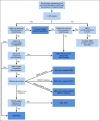Management Approach to Acute Myeloid Leukemia Leveraging the Available Resources in View of the Latest Evidence: Consensus of the Saudi Society of Blood and Marrow Transplantation
- PMID: 34343012
- PMCID: PMC8457782
- DOI: 10.1200/GO.20.00660
Management Approach to Acute Myeloid Leukemia Leveraging the Available Resources in View of the Latest Evidence: Consensus of the Saudi Society of Blood and Marrow Transplantation
Abstract
Purpose: Acute myeloid leukemia (AML) is the most prevalent acute leukemia in adults and is responsible for the majority of cancer-related mortality. In Saudi Arabia, leukemia is ranked the fifth most prevalent type of malignancy in adults. Our aim is to review existing epidemiologic data in Saudi Arabia and develop consensus guidelines for management of AML.
Methods: We review literature related to AML epidemiology, treatment patterns, and outcomes in Saudi Arabia, as well as literature related to the current advances in AML treatment. A panel of 10 experts from eight institutions in Saudi Arabia reviewed the literature and developed a consensus statement.
Result: We provide an update of the available AML epidemiologic data in Saudi Arabia and describe recent developments in the diagnostic workup, risk stratification, and treatment algorithm. The consensus recommendations for the management of AML in Saudi Arabia were developed.
Conclusion: The recommendations are in parallel with the recent international guidelines for the diagnosis and management of AML.
Conflict of interest statement
Figures





Similar articles
-
Patterns of the Leukemia Records that were Referred to the Regional Laboratory in Makkah, Saudi Arabia.Clin Lab. 2024 Aug 1;70(8). doi: 10.7754/Clin.Lab.2024.240210. Clin Lab. 2024. PMID: 39193960
-
Identifying Prognostic Factors That Influence Outcome of Childhood Acute Myeloid Leukemia in First Relapse in Saudi Arabia: Results of the Multicenter SAPHOS Study.Clin Lymphoma Myeloma Leuk. 2018 Dec;18(12):773-780. doi: 10.1016/j.clml.2018.09.001. Epub 2018 Sep 12. Clin Lymphoma Myeloma Leuk. 2018. PMID: 30340992
-
AML in Saudi Arabia: Analysis According to the European LeukaemiaNet 2017 Cytogenetic Classification.Clin Lymphoma Myeloma Leuk. 2020 May;20(5):e212-e220. doi: 10.1016/j.clml.2019.12.005. Epub 2019 Dec 24. Clin Lymphoma Myeloma Leuk. 2020. PMID: 32127298 Clinical Trial.
-
Pharmacological treatment of type 2 diabetes in Saudi Arabia: A consensus statement from the Saudi Society of Endocrinology and Metabolism (SSEM).Diabetes Metab Syndr. 2021 May-Jun;15(3):891-899. doi: 10.1016/j.dsx.2021.04.003. Epub 2021 Apr 20. Diabetes Metab Syndr. 2021. PMID: 33895710 Review.
-
Using benzodiazepines and Z-drugs for managing primary insomnia in adults in Saudi Arabia: an e-Delphi study to aid the development of clinical guidelines.Sleep Breath. 2019 Dec;23(4):1133-1139. doi: 10.1007/s11325-019-01794-7. Epub 2019 Feb 7. Sleep Breath. 2019. PMID: 30729406 Free PMC article.
Cited by
-
The miR-146b-3p/TNFAIP2 axis regulates cell differentiation in acute myeloid leukaemia.Aging (Albany NY). 2024 Jan 24;16(2):1496-1515. doi: 10.18632/aging.205441. Epub 2024 Jan 24. Aging (Albany NY). 2024. PMID: 38271140 Free PMC article.
-
Association of genetic predisposition studies in CYP1A1 polymorphism studies in acute myeloid leukemia.Saudi J Biol Sci. 2024 Mar;31(3):103917. doi: 10.1016/j.sjbs.2023.103917. Epub 2023 Dec 23. Saudi J Biol Sci. 2024. PMID: 38283773 Free PMC article.
-
Targeting acute myeloid leukemia through antibody engineering: innovations in immunotherapy and combination regimens.Clin Exp Med. 2025 Jun 24;25(1):215. doi: 10.1007/s10238-025-01764-2. Clin Exp Med. 2025. PMID: 40550903 Free PMC article. Review.
References
-
- Meyers J Yu Y Kaye JA, et al. : Medicare fee-for-service enrollees with primary acute myeloid leukemia: An analysis of treatment patterns, survival, and healthcare resource utilization and costs. Appl Health Econ Health Policy 11:275-286, 2013 - PubMed
-
- Miranda-Filho A Piñeros M Ferlay J, et al. : Epidemiological patterns of leukaemia in 184 countries: A population-based study. Lancet Haematol 5:e14-e24, 2018 - PubMed
-
- Cancer stat facts: Leukemia—acute myeloid leukemia (AML). https://seer.cancer.gov/statfacts/html/amyl.html
Publication types
MeSH terms
LinkOut - more resources
Full Text Sources
Medical

